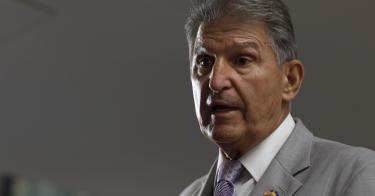Stagflation is here. Inflation notched a fresh 40-year high of 9.1 percent in June, and the economy shrank in the first and second quarters of the year.
Yet Sen. Joe Manchin, D-W.Va., and Senate Majority Leader Chuck Schumer, D-N.Y., are charging forward with a plan to slap businesses and individuals with more taxes. While there’s no good time to raise taxes, doing so in a down economy would be especially counterproductive.
This is a disappointing flip-flop from Manchin, who only a couple weeks ago shot down the idea of raising taxes on Americans without seeing data that shows inflation on the wane.
On July 15, Manchin told West Virginia radio host Hoppy Kercheval, “Inflation is absolutely killing many, many people… Can’t we wait to make sure that we do nothing to add to that? And I can’t make that decision on taxes of any type [without seeing a drop in inflation].”
>>> 4 Reasons Biden’s Pitch for Raising Business Taxes Is No Solution for Inflation
The new taxes in the 725-page Manchin-Schumer bill fall into three main categories: new taxes on businesses designed to raise revenues, punitive taxes on businesses designed to coerce, and an $80 billion expansion of the IRS mostly meant to beef up enforcement and audits on American taxpayers.
The largest revenue-raising tax hike would be a new minimum tax on businesses, estimated to raise $313 billion over 10 years. The corporate minimum tax would require businesses to calculate their tax liability under a complex parallel tax system based on financial statement income.
But don’t assume you’ll be untouched if you’re not a business owner. This tax hike, of course, adds to business costs both directly and indirectly by imposing a large compliance burden on business, most of which ultimately gets passed down in the form of lower wages and higher prices.
In the Medicare prescription drug market, the Manchin-Schumer bill resorts to effective tax rates of more than 100 percent on drug manufacturers as part of the enforcement mechanism for the government’s drug price-fixing schemes. The drug price controls would shift costs around but wouldn’t reduce inflation. Indeed, while the price of the 10-20 price-controlled drugs may fall specifically within the Medicare market, some estimates indicate that the price controls will lead to far fewer drugs being introduced in U.S. markets.
Live-saving medicines would not be available at any price. How’s that for stagflation?
The Manchin-Schumer bill also does an end-around to grab more taxes without (another) direct tax increase. By adding roughly 87,000 new agents to the IRS’s ranks, the senators hope to collect a total of about $200 billion more tax revenues from Americans through an estimated additional 1.2 million annual audits. Almost half of that additional revenue collected would go right back into the IRS.
Again, this doesn’t help end stagflation. Making hundreds of thousands more people work for the IRS or slog through an audit in a given year won’t free up the private sector to start producing again.
Typically, U.S. policymakers avoid raising taxes in a shrinking economy. When they’ve tried it in the past, it’s failed.
The most egregious example of piling on taxes in a recession followed the 1929 stock market crash. At least four major tax increases in the 1930s — the 1930 Smoot-Hawley tariffs, major 1932 individual tax hikes, the 1935 “Soak the Rich” tax, and the 1937 introduction of the payroll tax — helped deepen and extend the Great Depression. Nearly a decade after the market crash, in 1937 and 1938, America experienced a double-dip recession and the unemployment rate soared to 19 percent.
>>> Biden’s Newest “Build Back Better” Boondoggle Would Worsen Inflationary Squeeze on Middle America
While another Great Depression isn’t likely, Schumer and Manchin’s $1 trillion tax plan may well push the economy deeper into recession. This would be devastating for American families, but it would also be terrible news for America’s fiscal situation with the national debt already standing at $30.5 trillion.
After President George H.W. Bush broke his “No New Taxes” pledge in 1990 at the front end of a recession, not only did it worsen the recession, it failed to drive up federal revenues as intended. By 1992, tax revenues dropped to their lowest level as a percentage of GDP as at any point between 1985 and 2002.
Each of the last 12 U.S. recessions dating back to 1949 led to a decline in the growth of federal tax revenue. Falling economic output reduces Americans’ income and drops them into lower tax brackets. Since high-income Americans pay much more tax than low-income Americans, healthy economic growth is key to growth in tax revenues.
Manchin was right the first time. More taxes are not what America needs right now.
This piece originally appeared in ArcaMax




